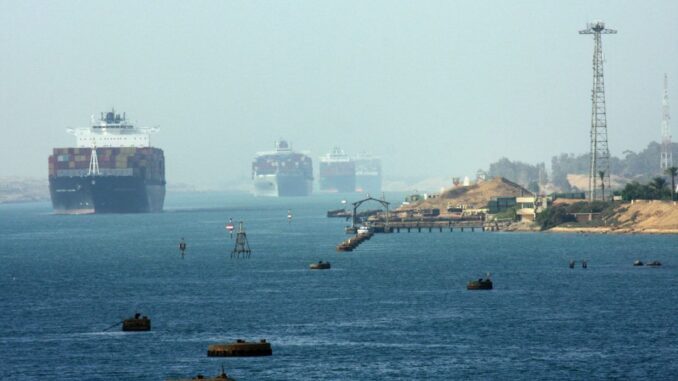
Suez traffic is down 28% in the past 10 days. Also, the commercial Suez Canal traffic reportedly downed almost 60% since the Houthi attacks began in response to the Israeli war on Gaza.
Short-term rates for container shipping between Asia, Europe, and the US are climbing on reduced capacity caused by the ongoing threats to cargo vessels in the Red Sea.
The spot rate for shipping goods in a 40-foot container from Asia to northern Europe now tops $4,000, a 173% jump from just before the diversions started in mid-December, Freightos.com, a cargo booking and payment platform, said late Wednesday.
The cost for goods from Asia to the Mediterranean increased to $5,175, Freightos said, adding that some carriers have announced prices above $6,000 for this route starting in mid-January. Rates from Asia to North America’s East Coast have risen 55% to $3,900 for a 40-foot container.
Services from Asia to northern Europe and to the Mediterranean both cost more than twice their levels in January 2019 but are still well below their peaks during the pandemic, said Judah Levine, head of research at Freightos.
The rate spike is part of the fallout from a slowdown in Suez Canal traffic, which has slumped by more than a quarter in recent days as vessels take longer routes to avoid missile strikes from Yemen’s Iran-backed Houthi militants. The Houthis say they are going after any vessels that have a connection with Israel, although those purported links have looked increasingly tenuous.
Shipping lines raise their prices when capacity is stretched, and add surcharges for the extra time it takes to deliver the goods and during busier-than-normal times of the year.
Meanwhile, blasts near the grave of Iranian commander Qassem Soleimani, that have killed nearly a 100 people, threaten to widen the Middle East conflict, with Tehran saying the attacks were carried out to punish its stance against Israel, although the US said neither Israel nor itself were involved.
“This is no longer taking place during the holiday lull either — demand may be increasing as shippers start to pull forward volumes to make up for longer transit times and in preparation for China’s Lunar New Year holiday in early February,” Levine said in a blog post. “Together, this could increase the risk of congestion.”
In the 10 days through Jan. 2, the number of Suez transits was down 28% from a year earlier, according to figures released Wednesday by the International Monetary Fund’s PortWatch platform, which is produced with Oxford University. That’s consistent with 3.1% of global commerce being diverted away from the Red Sea, according to the data.
The IMF called the Red Sea a “systemically important” shipping lane that handles more than 19,000 vessel transits a year. Reduced traffic has been observed since Dec. 16, the Washington-based institution said in the note.
For cargo owners seeing their freight costs rise, the risk is that spot rates will stay elevated and leave them with less leverage when they’re negotiating prices in long-term contracts, which typically takes place between March and May. Most ocean freight moves on rates set in these contracts.
The impact goes beyond the beyond the container sector.
Oil tanker markets have also seen some gains, shipbroker Braemar wrote in a research report, mostly for vessels hauling refined fuels like gasoline and diesel. Earnings for ships hauling refined fuels from the Mediterranean to Japan via the canal have climbed from about $8,000 a day in early December, to $26,000 this week.
“Any route involving the Red Sea is red hot,” the Braemar analysts said.
In the same context, commercial vessel volume in the Suez Canal has reportedly fallen by 59% when compared to volumes seen before Houthis started attacking commercial ships, based on a recent report.
According to a survey published January 3 by project44, entitled “Houthi Attacks Disrupt Global Supply Chains,” 207 ships that were originally routed to go through the Suez Canal have been impacted by Houthi attacks.
An estimated 181 vessels have been rerouted around Africa, while another 26 ships are opting to drift, which means they are staying stationary and attempting to wait out the ongoing Middle East conflict. Project44 predicts that most of the rerouted ships will see their transit times increase by seven to 20 days.
Project44 also said it expects the Houthi attacks to lead to more global oil supply disruptions as well as downstream global inventory issues that will likely pop up in February.
“As ocean carriers announce plans to reroute vessels around the canals, trade lanes that leverage the Suez Canal should be prepared for major delays,” reads the project44 report.
Also, Denmark’s Maersk (MAERSKb.CO) said on Thursday it has rerouted four out of five container vessels that were stuck in the Red Sea back towards the Suez Canal and the long journey around Africa to avoid the risk of attack.
Yemen-based Houthi militants recently attacked a number of vessels in the southern Red Sea, including a Maersk ship on Saturday, disrupting global trade and raising fears of a fresh bout of global inflation as shipping rates soared.
The United States on Dec. 19 launched a multinational operation to safeguard commerce in the Red Sea, but many shipping companies and cargo owners are still diverting vessels around Africa.
Maersk, which had last week briefly sought to restart Red Sea voyages after a pause, said on Tuesday its container ships would again avoid the route that gives access to the Suez Canal, a shortcut between Asia and Europe.
But five Maersk ships headed towards Asia had already traversed the canal from the north and were poised to travel south past Yemen when the pause was announced, leaving the crews and tens of thousands of containers in limbo.
The Maersk Genoa, Maersk Londrina, Ebba Maersk and Gjertrud Maersk container vessels, which had been sitting in the Red Sea just south of Saudi Arabia’s port of Jeddah in recent days, were on Thursday rerouted around the Cape of Good Hope, a Maersk schedule showed.
A fifth vessel, Maersk Utah, that had also been stuck in the area, had not yet been rerouted, but a Maersk spokesperson said it would not sail past Yemen.
Sending the ships back via the Suez Canal would incur fresh fees to pay for the passage through the canal and add significant delays and extra fuel costs for a journey around the Cape of Good Hope.
Maersk said last month it had imposed a transit disruption surcharge (TDS) and a peak season surcharge (PSS), adding a total of $700 to the cost of a standard 20-foot container travelling from China to Northern Europe.
The Suez Canal is used by roughly one-third of global container ship cargo, and re-directing ships around the southern tip of Africa is expected to cost up to $1 million extra in fuel for every round trip between Asia and Northern Europe.



